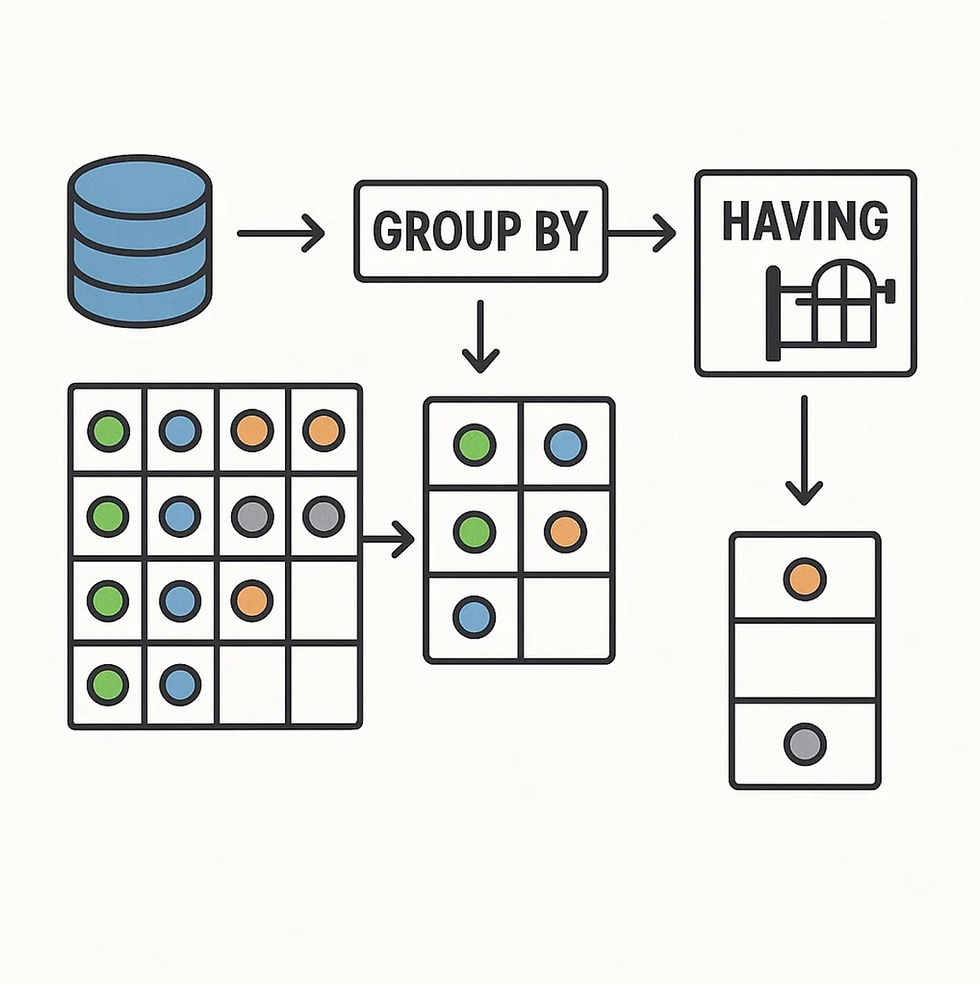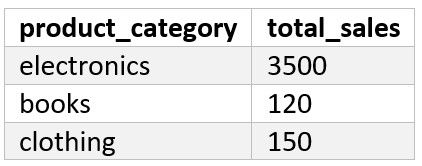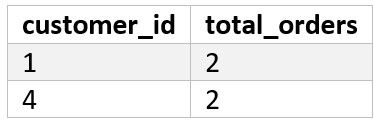Data Aggregation in MySQL: Understanding GROUP BY, HAVING, and Alternative Techniques
- Alex Ricciardi
- May 14
- 7 min read
This article explains how to use the GROUP BY and HAVING clauses in MySQL for data aggregation and details their syntax with examples. It also explores alternative methods for achieving similar data aggregation and summary, such as using correlated subqueries and window functions.
Alexander S. Ricciardi
May 14, 2025

Structured Query Language (SQL) is used within Relational Database Management Systems (RDBMS) to create and manipulate databases. MySQL is one of the various RDBMS frameworks that supports the GROUP BY and HAVING clauses for data aggregation. Data aggregation, in the context of RDBMS, is the process of taking multiple rows of data and summarizing them into a single result row, based on certain stated conditions or criteria. The GROUP BY and HAVING clauses are used in conjunction with aggregate functions like COUNT(), SUM(), AVG(), MAX(), and MIN(). This post describes the syntax and usage of the GROUP BY and HAVING clauses and explores alternative approaches to achieve similar data aggregation results using correlated subqueries and window functions.
The GROUP BY Clause
The GROUP BY clause is used to partition identical data (records) into groups (DataCamp, n.d.a). It is often used in conjunction with aggregate functions that perform calculations on the groups created by the clause. For example:
SELECT product_category, SUM(sale_amount) AS total_sales
FROM sales
GROUP BY product_categoryOutput Example:

Explanation of the Code:
1. SELECT product_category, SUM(sale_amount) AS total_salesproduct_category
product_category column will be included in the results.
SUM(sale_amount) AS total_sales: Aggregate function that calculates the sum of values in the sale_amount column and assigns results to the column with the alias total_sales.
2. FROM sales
The table from which the data is retrieved.
3. GROUP BY product_category
Partition the records (rows) with identical product_category values into groups. For example, if there are multiple sales records for "Electronics" (product_category ), all these records will form one group; all sales records for "Books" (product_category ) will form another group, and so on.
Then the aggregate function SUM(sale_amount) will compute the sum of the sale_amount and the results are stored in the column total_sales (AS total_sales).
The HAVING Clause
The HAVING Clause is used to filter identical data partitioned by the GROUP BY clause (DataCamp, n.d.b). Note that the clause after For example:
SELECT product_category, SUM(sale_amount) AS total_sales
FROM sales
GROUP BY product_category
HAVING SUM(sale_amount) > 200Output Example:

Explanation of the Code:
1. SELECT product_category, SUM(sale_amount) AS total_salesproduct_category
product_category column will be included in the results.
SUM(sale_amount) AS total_sales: Aggregate function that calculates the sum of values in the sale_amount column and assigns results to the column with the alias total_sales.
2. FROM sales
The table from which the data is retrieved.
3. GROUP BY product_category
Partition the records (rows) with identical product_category values into groups. For example, if there are multiple sales records for "Electronics" (product_category ), all these records will form one group; all sales records for "Books" (product_category ) will form another group, and so on.
Then the aggregate function SUM(sale_amount) will compute the sum of the sale_amount and the results are stored in the column total_sales (AS total_sales).
4. HAVING SUM(sale_amount) > 200
The HAVING clause filters the groups that were created by the GROUP BY clause. The clause is applied after the grouping has occurred and the sum of the sale_amount has been computed for each group.
SUM(sale_amount) > 200 is the condition. Only the groups (product_categories) with a total sum (sale_amount) greater than 200 will be included in the final result.
Rewriting Example
In this section, the provided example below using the GROUP BY and HAVING clauses is rewritten by utilizing first correlated subqueries and then MySQL window functions to showcase approaches to achieve the same data aggregation, but with different methods.
On a side note: the ORDER BY clause is a SQL command used to sort query results in either ascending or descending order based on one or more columns (Kartik, 2024). MySQL query statement utilizing GROUP BY clause in conjunction with aggregate functions often uses the ORDER BY to arrange the aggregated results in a more meaningful way, for example, by ranking the groups based on their computed aggregate results (e.g., showing product categories with the highest SUM(sales) first, or customers with the COUNT(orders) in descending order). Below is an example illustrating the combined use of the GROUP BY, HAVING, and ORDER BY clauses. Here we want to identify and rank customers who have multiple orders by the number of orders they have made.
SELECT
customer_id,
COUNT(order_id) AS total_orders
FROM
orders
GROUP BY
customer_id
HAVING
COUNT(order_id) > 1
ORDER BY
total_orders DESC
LIMIT 10;Output Example:

Explanation of the Code:
SELECT customer_id, COUNT(order_id) AS total_orders
Selects the customer_id column.
COUNT(order_id) counts the number of orders for each customer.
AS total_orders gives an alias to the calculated count column.
FROM orders
The table from which the data is retrieved.
GROUP BY customer_id
Partition the records (rows) with identical customer_id values into groups.
Then the aggregate function COUNT(order_id) will count the number of rows (records) in the order_id column, including the row with NULL values.
HAVING COUNT(order_id) > 1
The HAVING clause filters the groups that were created by the GROUP BY clause. The clause is applied after grouping has occurred and the count of the total_orders has been computed for each group.
COUNT(order_id) > 1 is the condition. Only the groups (total_orders) with a total count superior then 1 will be included in the final result
ORDER BY total_orders DESC
Sorts the total_orders results in descending order.
LIMIT 10
This limits the number of total_orders results output to a maximum of ten rows.
Rewriting The Query Without the GROUP BY and HAVING Clauses
By Using Correlated Subqueries
It is possible to rewrite the last example without using the GROUP BY and HAVING clauses. For example, by using subqueries (subqueries, in MySQL, are queries embedded in other queries):
SELECT
customer_id,
total_orders
FROM
( -- Subquery substitute for the GROUP BY clause
SELECT
cust_with_orders.customer_id,
( -- Sub-subquery-2 counts the total number of orders for
each distinct customer id
SELECT COUNT(order_id)
FROM orders
WHERE customer_id = cust_with_orders.customer_id
) AS total_orders
FROM
( -- Sub-subquery-1 queries all unique customer ids that
exist in the orders table
SELECT DISTINCT customer_id
FROM orders
) AS cust_with_orders
) AS group_orders_by_customer_id -- output table
WHERE -- substitute for the HAVE clause
total_orders > 1
ORDER BY
total_orders DESC
LIMIT 10;Output Example:

Explanation of the Code: (For the sake of length, the code explanation is summarized)
Sub-subquery-1, a list (cust_with_orders) of all distinct customer ids from the orders table is created. Note that the created list is a table consisting of one column (customer_id).
Then, sub-subquery-2, counts for each distinct customer id (cust_with_orders.customer_id), their number of orders from the orders table is counted, and outputs a list of total orders (total_orders). Note that the output is a column.
These results (total_orders) and their related customer ids (cust_with_orders.customer_id) are merged in a table with the alias group_orders_by_customer_id. Note that the combination of the previous steps simulates the GROUP BY clause functionality.
Then the values of the group_orders_by_customer_id are filtered using a WHERE clause with the condition total_orders > 1. Note that the WHERE clause is the substitute for the HAVE clause.
Although the query using the GROUP BY and HAVING clauses can be written by using correlated subqueries is more verbose, making it more difficult to read, and is more often than not less performant for aggregation operations than the GROUP BY clause. Another alternative is to use window functions, which are supported by MySQL.
Using Window Functions to Rewrite the Query
Window functions can perform aggregations, rankings, distributions, and more without collapsing the entire result set down to a single row (PlanetScale, 2025). It is possible to rewrite the query example without using the GROUP BY and HAVING clauses. For example:
-- Window function
-- The function counts the number of orders per customer id in the order table
-- it outputs a table where each original row (containing a customer_id)
-- also contains the total number of orders for that specific customer_id
WITH customer_order_counts AS (
SELECT
customer_id,
-- The 'orders' table's data is partitioned by customer_id
-- and each occurrence of the customer_id is associated with
-- the total number of orders for that specific customer_id
-- computed by the COUNT(order_id) clause
COUNT(order_id) OVER (PARTITION BY customer_id) AS total_orders
FROM
orders
)
-- -------------------------------------------------------------------
-- This is the Main query
SELECT DISTINCT
customer_id, -- Only select distinct customer_id
total_orders
FROM
customer_order_counts
WHERE
total_orders > 1
ORDER BY
total_orders DESC
LIMIT 10;Output Example:

Explanation of the Code: (For the sake of length, the code explanation is summarized)
The query first calculates the total number of orders for every customer ids from the orders table and attaches the respective totals to each occurrent customer_id using the customer_order_counts window function. Not that this function creates duplicate rows
Then, it filters distinct customer ids (from the customer_order_counts table) with their total order counts, then filters out customers who have only made 1 order, sorts the remaining customers by their total order count (highest first), and finally, it only returns the top 10 row results.
Similarly to using the correlated subqueries, the query can be rewritten using window functions. The query is more verbose than the one using the GROUP BY clause, making it less readable and concise. It is also less performant, as it computes the total order count for every individual row of the orders table, creating duplicates. Window functions should be used in scenarios like calculating per-row values like ranks, running totals, or lead/lag comparisons, and where keeping the individual row context is needed.
To summarize, the GROUP BY and HAVING clauses in MySQL are essential for data aggregation tasks. They are often used in conjunction with aggregate functions like SUM() and COUNT(), allowing for powerful data summarization. Although it is possible to summarize data through aggregation without using the GROUP BY and HAVING clauses by utilizing correlated queries or window functions. However, these alternative methods often result in more verbose queries and less performance, making GROUP BY and HAVING generally the more direct, concise, and often more efficient for standard aggregation tasks.
References:
DataCamp (n.d.a). MySQL GROUP BY clause. DataCamp. https://www.datacamp.com/doc/mysql/mysql-group-by
DataCamp (n.d.b). MySQL HAVING clause. DataCamp. https://www.datacamp.com/doc/mysql/mysql-having
PlanetScale (2025). 3.15 Window functions. MySQL for developers. PlanetScale. https://planetscale.com/learn/courses/mysql-for-developers/queries/window-functions?autoplay=1





Comments